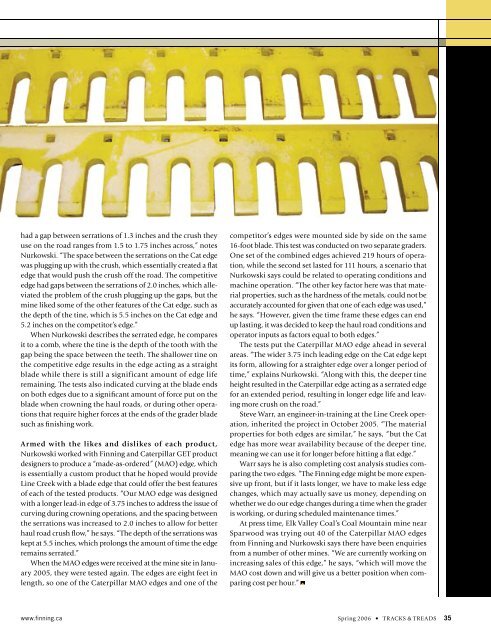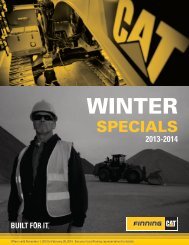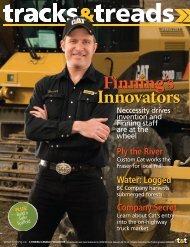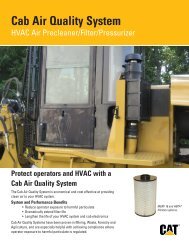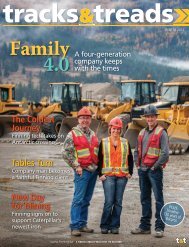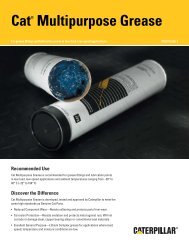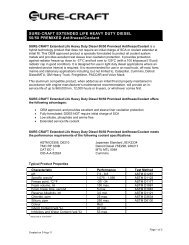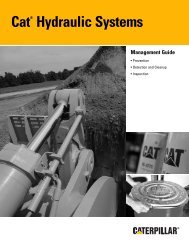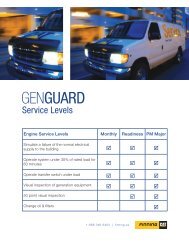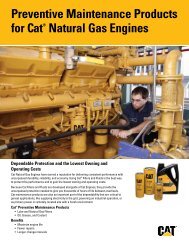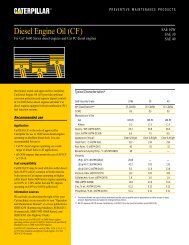Wanted Tour - Finning Canada
Wanted Tour - Finning Canada
Wanted Tour - Finning Canada
You also want an ePaper? Increase the reach of your titles
YUMPU automatically turns print PDFs into web optimized ePapers that Google loves.
had a gap between serrations of 1.3 inches and the crush theyuse on the road ranges from 1.5 to 1.75 inches across,” notesNurkowski. “The space between the serrations on the Cat edgewas plugging up with the crush, which essentially created a flatedge that would push the crush off the road. The competitiveedge had gaps between the serrations of 2.0 inches, which alleviatedthe problem of the crush plugging up the gaps, but themine liked some of the other features of the Cat edge, such asthe depth of the tine, which is 5.5 inches on the Cat edge and5.2 inches on the competitor’s edge.”When Nurkowski describes the serrated edge, he comparesit to a comb, where the tine is the depth of the tooth with thegap being the space between the teeth. The shallower tine onthe competitive edge results in the edge acting as a straightblade while there is still a significant amount of edge liferemaining. The tests also indicated curving at the blade endson both edges due to a significant amount of force put on theblade when crowning the haul roads, or during other operationsthat require higher forces at the ends of the grader bladesuch as finishing work.Armed with the likes and dislikes of each product,Nurkowski worked with <strong>Finning</strong> and Caterpillar GET productdesigners to produce a “made-as-ordered” (MAO) edge, whichis essentially a custom product that he hoped would provideLine Creek with a blade edge that could offer the best featuresof each of the tested products. “Our MAO edge was designedwith a longer lead-in edge of 3.75 inches to address the issue ofcurving during crowning operations, and the spacing betweenthe serrations was increased to 2.0 inches to allow for betterhaul road crush flow,” he says. “The depth of the serrations waskept at 5.5 inches, which prolongs the amount of time the edgeremains serrated.”When the MAO edges were received at the mine site in January2005, they were tested again. The edges are eight feet inlength, so one of the Caterpillar MAO edges and one of thecompetitor’s edges were mounted side by side on the same16-foot blade. This test was conducted on two separate graders.One set of the combined edges achieved 219 hours of operation,while the second set lasted for 111 hours, a scenario thatNurkowski says could be related to operating conditions andmachine operation. “The other key factor here was that materialproperties, such as the hardness of the metals, could not beaccurately accounted for given that one of each edge was used,”he says. “However, given the time frame these edges can endup lasting, it was decided to keep the haul road conditions andoperator inputs as factors equal to both edges.”The tests put the Caterpillar MAO edge ahead in severalareas. “The wider 3.75 inch leading edge on the Cat edge keptits form, allowing for a straighter edge over a longer period oftime,” explains Nurkowski. “Along with this, the deeper tineheight resulted in the Caterpillar edge acting as a serrated edgefor an extended period, resulting in longer edge life and leavingmore crush on the road.”Steve Warr, an engineer-in-training at the Line Creek operation,inherited the project in October 2005. “The materialproperties for both edges are similar,” he says, “but the Catedge has more wear availability because of the deeper tine,meaning we can use it for longer before hitting a flat edge.”Warr says he is also completing cost analysis studies comparingthe two edges. “The <strong>Finning</strong> edge might be more expensiveup front, but if it lasts longer, we have to make less edgechanges, which may actually save us money, depending onwhether we do our edge changes during a time when the grade ris working, or during scheduled maintenance times.”At press time, Elk Valley Coal’s Coal Mountain mine nearSparwood was trying out 40 of the Caterpillar MAO edgesfrom <strong>Finning</strong> and Nurkowski says there have been enquiriesfrom a number of other mines. “We are currently working onincreasing sales of this edge,” he says, “which will move theMAO cost down and will give us a better position when comparingcost per hour.”www.finning.ca Spring 2006 • TRACKS & TREADS 35


